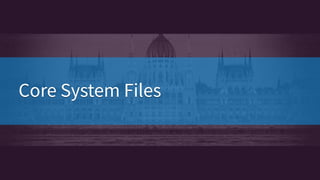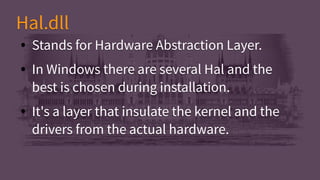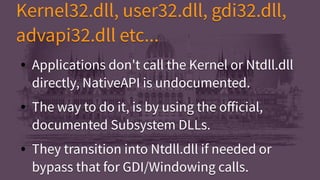Windows internals Essentials
- 1. Windows Internals (introduction)Windows Internals (introduction) John OmbagiJohn Ombagi
- 3. ● Basic Operating System Concepts. ● How the Windows OS is implemented. ● Simplified inner working of this OS. ● Not a detail guide. ● Basic Operating System Concepts. ● How the Windows OS is implemented. ● Simplified inner working of this OS. ● Not a detail guide. OverviewOverview
- 4. Expectation & Literature ● Knowledge gained can be applied in: – Malware analysis & reverse engineering – Exploit development & software development. ● Books Required: – Windows Internals 6 (part one and two). – The recent Windows Internals 7 (part one). ● Knowledge gained can be applied in: – Malware analysis & reverse engineering – Exploit development & software development. ● Books Required: – Windows Internals 6 (part one and two). – The recent Windows Internals 7 (part one).
- 5. User mode & Kernel modeUser mode & Kernel mode
- 6. ● Allows access to non-operating system code and data only ● No access to the hardware ● Protect user application form crashing the system ● Allows access to non-operating system code and data only ● No access to the hardware ● Protect user application form crashing the system User modeUser mode
- 7. ● Privileged mode for use by the kernel and device drivers only. ● Allows access to all system resources ● Can potentially crash system (BoD?) ● Privileged mode for use by the kernel and device drivers only. ● Allows access to all system resources ● Can potentially crash system (BoD?) Kernel modeKernel mode
- 8. Lab Setup ● Windows 7/8/10 (I’ll be using 32 bit). ● Windbg, OllyDbg, Immunituy, x64dbg ● IDA Pro ver. 6 or 7 ● Windows System internals Suite ● Python 2.7 ● Provided Workshop Tools ● Windows 7/8/10 (I’ll be using 32 bit). ● Windbg, OllyDbg, Immunituy, x64dbg ● IDA Pro ver. 6 or 7 ● Windows System internals Suite ● Python 2.7 ● Provided Workshop Tools
- 10. ● It’s a set of resources to execute a program.● It’s a set of resources to execute a program. What’s a Process?What’s a Process?
- 11. ● A private Virtual Address space. ● An executable program ● A private table of handles to various kernel objects ● A security context (access token) ● One or more threads that execute code. ● A private Virtual Address space. ● An executable program ● A private table of handles to various kernel objects ● A security context (access token) ● One or more threads that execute code. What constitute a process?What constitute a process?
- 12. ThreadsThreads
- 13. ● This is an entity that is scheduled by the kernel to execute code. ● This is an entity that is scheduled by the kernel to execute code. What’s a Thread?What’s a Thread?
- 14. ● The state of CPU registers ● Current access mode ● Two stacks, (userspace and kernel space) ● Thread Local Storage (TLS) ● Optional Security Token ● Optional message queue ● The state of CPU registers ● Current access mode ● Two stacks, (userspace and kernel space) ● Thread Local Storage (TLS) ● Optional Security Token ● Optional message queue What constitute a thread?What constitute a thread?
- 15. ● There are several states but the most important ones are as follows: – Running – Ready – Waiting ● There are several states but the most important ones are as follows: – Running – Ready – Waiting Thread StateThread State
- 16. Demo
- 18. ● Each process "sees" a flat linear memory. ● Virtual memory may be mapped to physical memory, but may also be stored on disk. ● Processes access memory regardless of where it actually resides. ● The memory manager handles mapping of virtual to physical page. ● Each process "sees" a flat linear memory. ● Virtual memory may be mapped to physical memory, but may also be stored on disk. ● Processes access memory regardless of where it actually resides. ● The memory manager handles mapping of virtual to physical page. OverviewOverview
- 20. ● Windows Internals, Sixth Edition, Part 1 (page 15) – Virtual Memory Mapping – Virtual Memory Layout ● Windows Internals, Sixth Edition, Part 1 (page 15) – Virtual Memory Mapping – Virtual Memory Layout Further ReadingFurther Reading
- 21. Demo.
- 22. Object and HandlesObject and Handles
- 23. ● Windows is an object based system. ● Objects are run time instance of static structures & reside in system memory space. ● Kernel code can obtain direct pointer to an object. In user mode, code can only obtain a handle to an object. ● Objects are reference counted. ● Windows is an object based system. ● Objects are run time instance of static structures & reside in system memory space. ● Kernel code can obtain direct pointer to an object. In user mode, code can only obtain a handle to an object. ● Objects are reference counted. DetailsDetails
- 24. Windows Design GoalWindows Design Goal
- 25. ● Separate address space per process. ● Protected Kernel. ● Pre-emptive multitasking & multithreading. ● Internationalization support using Unicode. ● Security throughout the System. ● Integrated Networking. ● Separate address space per process. ● Protected Kernel. ● Pre-emptive multitasking & multithreading. ● Internationalization support using Unicode. ● Security throughout the System. ● Integrated Networking. OverviewOverview
- 26. ● Powerful File System (NTFS). ● Run most 16 bit Windows and DOS. applications. ● Run POSIX 1003.1 and OS/2 applications. ● Portable across processors and platforms. ● Be great client as well as server platform. ● Powerful File System (NTFS). ● Run most 16 bit Windows and DOS. applications. ● Run POSIX 1003.1 and OS/2 applications. ● Portable across processors and platforms. ● Be great client as well as server platform. Cont.Cont.
- 27. Core System FilesCore System Files
- 28. ● On 64 bit Systems, we have Ntoskrnl.exe ● On 32 bit Systems, we have NtKrnlPa.exe – Physical Address Extensions (PAE) kernel ● PAE uses paging tables to map the memory greater than 4 GB. ● On 64 bit Systems, we have Ntoskrnl.exe ● On 32 bit Systems, we have NtKrnlPa.exe – Physical Address Extensions (PAE) kernel ● PAE uses paging tables to map the memory greater than 4 GB. Executive and KernelExecutive and Kernel
- 29. ● Stands for Hardware Abstraction Layer. ● In Windows there are several Hal and the best is chosen during installation. ● It's a layer that insulate the kernel and the drivers from the actual hardware. ● Stands for Hardware Abstraction Layer. ● In Windows there are several Hal and the best is chosen during installation. ● It's a layer that insulate the kernel and the drivers from the actual hardware. Hal.dllHal.dll
- 30. ● It's a Kernel mode component of the Windows subsystem. ● It handles Windowing and GDI (Graphics). ● It's a Kernel mode component of the Windows subsystem. ● It handles Windowing and GDI (Graphics). Win32k.sysWin32k.sys
- 31. ● It's the lower layer of the user mode. ● It has System support routines and Native API dispatcher to execute services. ● It provides functions to jump into Kernel mode. ● Provides other simple functions that are similar to the C runtime library. ● It's the lower layer of the user mode. ● It has System support routines and Native API dispatcher to execute services. ● It provides functions to jump into Kernel mode. ● Provides other simple functions that are similar to the C runtime library. NtDll.dllNtDll.dll
- 32. ● Applications don't call the Kernel or Ntdll.dll directly, NativeAPI is undocumented. ● The way to do it, is by using the official, documented Subsystem DLLs. ● They transition into Ntdll.dll if needed or bypass that for GDI/Windowing calls. ● Applications don't call the Kernel or Ntdll.dll directly, NativeAPI is undocumented. ● The way to do it, is by using the official, documented Subsystem DLLs. ● They transition into Ntdll.dll if needed or bypass that for GDI/Windowing calls. Kernel32.dll, user32.dll, gdi32.dll, advapi32.dll etc... Kernel32.dll, user32.dll, gdi32.dll, advapi32.dll etc...
- 33. CSRSS.exeCSRSS.exe ● Client Server Runtime Subsystem ● This is the process that manages the Windows Subsystem. ● It's very important and always running ● Killing this process will result into a blue screen of death. ● Client Server Runtime Subsystem ● This is the process that manages the Windows Subsystem. ● It's very important and always running ● Killing this process will result into a blue screen of death.
- 35. ● All CPUs are the same and share main memory and have equal access to peripheral devices. ● No Master or Slave CPUs. ● Basic architecture supports up to 32/64 CPUs. ● All CPUs are the same and share main memory and have equal access to peripheral devices. ● No Master or Slave CPUs. ● Basic architecture supports up to 32/64 CPUs. SMPSMP
- 36. ● It used bitmask, which was the size of the machine WORD. ● However starting on Windows 7 64 bit and 2008 R2 support up to 256 cores. A Processor Group can contain up to 64 Processors, there are four possible processor groups in a 256 core system. ● It used bitmask, which was the size of the machine WORD. ● However starting on Windows 7 64 bit and 2008 R2 support up to 256 cores. A Processor Group can contain up to 64 Processors, there are four possible processor groups in a 256 core system. SMP cont.SMP cont.
- 38. ● It exposes service via subsystem DLLS. ● These subsystem DLLs expose the API of that subsystem in a way that is fitting to that subsystem. ● The Windows subsystem must always be running. ● It’s loaded automatically during boots up ● It exposes service via subsystem DLLS. ● These subsystem DLLs expose the API of that subsystem in a way that is fitting to that subsystem. ● The Windows subsystem must always be running. ● It’s loaded automatically during boots up OverviewOverview
- 39. Subsytems cont..Subsytems cont.. ● Information about Subsystems are stored in the following registry key: – HKLMSystemCCSControlSession MangerSubsystems ● Subsystems DLLs are the ones exposing a particular API. ● Information about Subsystems are stored in the following registry key: – HKLMSystemCCSControlSession MangerSubsystems ● Subsystems DLLs are the ones exposing a particular API.
- 40. Cont.Cont. ● An image of a certain subsystem calls API functions exposed through the subsystem DLLs. ● Some processes start up before the Windows Subsystem is up. ● Most dispatcher to kernel services are using Windows API "wrappers". ● An image of a certain subsystem calls API functions exposed through the subsystem DLLs. ● Some processes start up before the Windows Subsystem is up. ● Most dispatcher to kernel services are using Windows API "wrappers".
- 42. Idle Process.Idle Process. ● it has an id a PID of 0 which is not a real process. ● It's just one thread per CPU (core). ● It's a count for Idle time. ● it has an id a PID of 0 which is not a real process. ● It's just one thread per CPU (core). ● It's a count for Idle time.
- 43. System ProcessSystem Process ● It's a real process and has a fixed PID of 4. ● It represent stuff going on in the Kernel ● It execute code in system space only. ● Created by PsCreateSystemThread kernel API ● The threads don't need a particular process to maintain running (on as System is alive) ● It's a real process and has a fixed PID of 4. ● It represent stuff going on in the Kernel ● It execute code in system space only. ● Created by PsCreateSystemThread kernel API ● The threads don't need a particular process to maintain running (on as System is alive)
- 44. Session manger (Smss.exe)Session manger (Smss.exe) ● It runs the windowssystem32smss.exe ● it’s the first user mode process created by System (the kernel, part of the boot process) ● Because at this time the windows Subsystem is not loaded yet, it uses the Native API provided by the NtDll.dll. ● It runs the windowssystem32smss.exe ● it’s the first user mode process created by System (the kernel, part of the boot process) ● Because at this time the windows Subsystem is not loaded yet, it uses the Native API provided by the NtDll.dll.
- 45. Session manger contd...Session manger contd... – Creating system environment variables. – launching the subsystem processes – It also launches itself in other sessions – Waits for csrss.exe instances to terminate. – Waits for subsystem creation request. – Waits for terminal services session creation requests. – Creating system environment variables. – launching the subsystem processes – It also launches itself in other sessions – Waits for csrss.exe instances to terminate. – Waits for subsystem creation request. – Waits for terminal services session creation requests.
- 46. Windows Subsystem (Csrss.exe)Windows Subsystem (Csrss.exe) ● It runs windowssystem32csrss.exe ● Provides the user mode side of the Win32 subsystem. ● CSRSS is mainly responsible for Win32 console handling and GUI shutdown. ● It is critical to system operation ● It runs windowssystem32csrss.exe ● Provides the user mode side of the Win32 subsystem. ● CSRSS is mainly responsible for Win32 console handling and GUI shutdown. ● It is critical to system operation
- 47. Logon Process (Winlogon.exe)Logon Process (Winlogon.exe) ● It runs windowssystem32winlogon.exe – This handles interactive logons and logoffs. If terminated, logs off the user session – It's also responsible for capturing of Secure Attention Sequence (SAS) - Ctrl + Alt + Del – Presents username / password dialog (through LogonUI.exe). ● It runs windowssystem32winlogon.exe – This handles interactive logons and logoffs. If terminated, logs off the user session – It's also responsible for capturing of Secure Attention Sequence (SAS) - Ctrl + Alt + Del – Presents username / password dialog (through LogonUI.exe).
- 48. Local Sec. Auth. Server (Lsass.exe)Local Sec. Auth. Server (Lsass.exe) ● Running the windowssystem32lsass.exe ● It calls the appropriate authentication packages. ● Upon successful authentication, creates a token representing the user's security profile. ● Returns information to Winlogon. ● Running the windowssystem32lsass.exe ● It calls the appropriate authentication packages. ● Upon successful authentication, creates a token representing the user's security profile. ● Returns information to Winlogon.
- 49. Service Control Manager (SCM)Service Control Manager (SCM) ● Running windowssystem32services.exe – Responsible for starting, stopping and interacting with service processes. – SERVICE : Similar to 'Unix' daemon processes; Not running in Kernel mode in any way; Normal Windows executable that interact with SCM; Can run under "special" accounts (LocalSystem, NetworkService, LocalService). ● Running windowssystem32services.exe – Responsible for starting, stopping and interacting with service processes. – SERVICE : Similar to 'Unix' daemon processes; Not running in Kernel mode in any way; Normal Windows executable that interact with SCM; Can run under "special" accounts (LocalSystem, NetworkService, LocalService).
- 50. Local Session Manager (Lsm.exe)Local Session Manager (Lsm.exe) – A helper Introduced in Windows Vista that does some managing of the local session and provides information to smss.exe if needed. – Running image windowssystem32lsm.exe – In windows 8, turned into a service. – Manages terminal sessions on the local machine – A helper Introduced in Windows Vista that does some managing of the local session and provides information to smss.exe if needed. – Running image windowssystem32lsm.exe – In windows 8, turned into a service. – Manages terminal sessions on the local machine
- 51. Wow64 (Windows in Windows 64)Wow64 (Windows in Windows 64) Wow64 allows execution of Win32 (32 bit exes) binaries on 64-bit Windows. – The isWow64Process function can tell whether a process is running under Wow64. – Filesystem: ● windowssystem32 contains 64 bit images ● windowssyswow64 containd 32 bit images Wow64 allows execution of Win32 (32 bit exes) binaries on 64-bit Windows. – The isWow64Process function can tell whether a process is running under Wow64. – Filesystem: ● windowssystem32 contains 64 bit images ● windowssyswow64 containd 32 bit images
- 52. Wow64-ArchWow64-Arch ● Wow64 Restrictions: – A 64 bit process cannot load a 32 bit DLLs and vice versa except resource-only DLLs. ● Filesystem Redirection: – WindowsSystem32 maps to WindowsSyswow64. – Program Files (x86) & Program Files ● Wow64 Restrictions: – A 64 bit process cannot load a 32 bit DLLs and vice versa except resource-only DLLs. ● Filesystem Redirection: – WindowsSystem32 maps to WindowsSyswow64. – Program Files (x86) & Program Files
- 53. ● Registry Redirection: ● COM components trying to register as 32 bit and 64 bit will crush. ● 32 bit components are redirected to the Wow64 registry node (Wow6432Node) – HKYE_LOCAL_MACHINESSoftware – HKEY_CLASSES_ROOT – HKEY_CURRENT_USERSoftwareClasses ● New flags for Registry APIs allow access to the 64 bit or 32 bit nodes – KEY_WOW64_64KEY & KEY_WOW64_32KEY ● Registry Redirection: ● COM components trying to register as 32 bit and 64 bit will crush. ● 32 bit components are redirected to the Wow64 registry node (Wow6432Node) – HKYE_LOCAL_MACHINESSoftware – HKEY_CLASSES_ROOT – HKEY_CURRENT_USERSoftwareClasses ● New flags for Registry APIs allow access to the 64 bit or 32 bit nodes – KEY_WOW64_64KEY & KEY_WOW64_32KEY
- 54. End of Part One. John Ombagi [email protected] End of Part One. John Ombagi [email protected]






















































